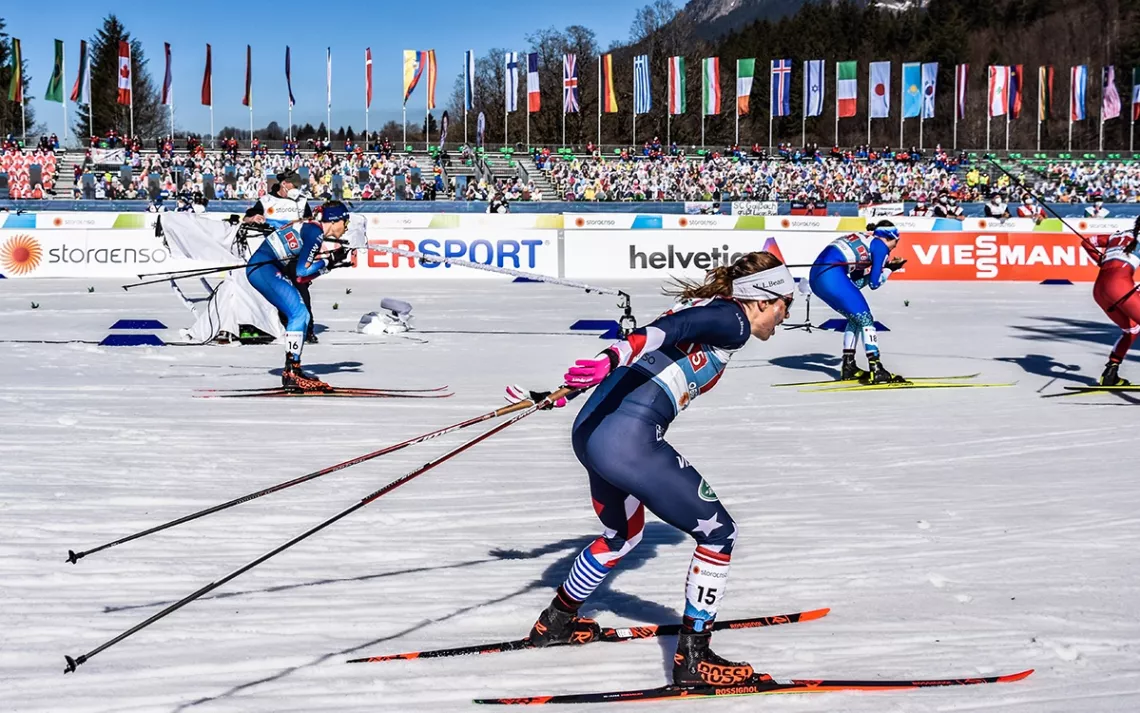How Women Skiers Won a Landmark Equality Victory
This winter all cross-country skiers will race equal distances

American cross-country skier Rosie Brennan competes in the 2021 FIS Cross Country World Championships in Oberstdorf, Germany. | Photos by US Ski & Snowboard
When Molly Peters arrived at Middlebury College as a freshman cross-country ski racer in 1993, she was rankled by a strange asymmetry. Though female skiers often trained alongside their male counterparts, their official races were much, much shorter.
If women went 15 kilometers, the men skied 30. In longer ski marathons, women raced 30 kilometers while men competed on a 50-kilometer course. “It never really sat well with me—in my mind, there was no reason for it,” said Peters, who now coaches both skiers and runners at Saint Michael’s College in Colchester, Vermont. “Women were fully capable of going the longer distances, but they were never allowed to.”
Though the issue nettled Peters for years, she got little traction whenever she brought it up to officials. But times change: In 2021, Peters gathered a coalition of skiers to write an open letter calling equal race distances an “important step forward for equity and inclusion.” And this May, the International Ski Federation (FIS) announced that men and women would, starting this winter, race equal distances. “I screamed and jumped around in my kitchen,” said Peters, of the moment she heard the news. “Then I called and texted and emailed every person I know.”
Peters’s push to equalize race distances, #SkiEqual, is just one of the ways athletes are seeking parity in sports worldwide. Efforts to narrow the gender pay gap for professional athletes have become increasingly prominent; in May, women’s soccer players were awarded $24 million after suing for equal pay. Some sporting organizations are also moving to minimize long-standing competitive differences. Starting in 2023, for example, the European Cross-Country Championships will equalize running races for men and women.
Moves to equalize sports send a critical message to young athletes, said Jessie Diggins, a skier who, along with teammate Kikkan Randall, won the United States’ first-ever Olympic gold medal in 2018. “I think it's just a really important step forward to essentially tell people who identify as women, from a very young age, that you are just as capable as anyone else of skiing this super challenging, long race,” she said.

Such changes confront spurious beliefs that women are uniquely vulnerable to overexertion, said Susan Barton, an honorary visiting research fellow at De Montfort University’s International Centre for Sports History and Culture. “Some of it was for pseudo-medical reasons,” she said, explaining that from 1928 until 1960, women were banned from running more than 200 meters at the Olympics for fear of “collapse.” When the first women’s Olympic marathon took place in 1984, some reportedly worried runners’ uteri might fall out; a sexist concern for women’s fertility helped bar female athletes from Olympic ski jumping until 2014.
Diggins, too, sees the fear for women’s health as patronizing and baseless. “I train the same or more than some of my male counterparts. I work just as hard. I’m just as capable,” she said. “It’s just as taxing—or not—on my body, the risks are the same.” Skier Bill Koch, a #SkiEqual signatory who in 1976 became the first American to win an Olympic medal in cross-country skiing, said that despite the rules, many athletes have long understood that.
“It’s obvious to me that men and women ought to race the same distance,” Koch said. In fact, he mused, competitions genuinely tailored to physiological differences between male and female athletes would have women racing longer—not shorter—distances than men. As has been widely observed, female athletes excel at endurance, drawing closer, on average, to their male counterparts as they tackle progressively longer runs, swims, and other events. “If men have a 50 [kilometer race], women should have a 70, as far as I’m concerned,” Koch said.
Months after learning about the equal-distance decision she helped inspire, Molly Peters is still thrilled by the news. Last year, the female athletes she coaches at Saint Michael’s College got the first taste of equal-distance racing when participating in the 20-kilometer Colby Carnival ski event. “That was the moment when they felt it the most,” Peters said. “It was like, ‘Oh wait, we really never have been allowed to do this race, and now we can, and that’s pretty amazing.’” Hearing from those young athletes, she explained, helps keep her energized.
Still, she noted, while cross-country ski racing’s newfound equity is a significant win worth celebrating, there’s more work to be done. Many sports still have a massive gender pay gap. Across the United States, conservative activists are attempting to leverage equal-rights legislation to unfairly exclude trans athletes from locker rooms, teams, and sporting events. And many female athletes, including the cross-country runners Peters coaches each fall, are still stuck with unequal race distances.
Peters wants to change that too. The organization she founded to equalize cross-country skiing is pushing the NCAA to do the same for cross-country running races. Earlier this year, Peters submitted a #RunEqual proposal to the NCAA, asking that collegiate racing offer equal distances to women and men.
“Requiring women to race shorter distances is gender bias and sends an unmistakable message, intended or not, that women are not as capable as men. This needs to change,” she wrote.
In August, the NCAA responded, denying the proposal while citing concerns that women might not want to run the eight-kilometer, equal-length races that #RunEqual has proposed. Peters categorically disagrees—and she’s currently working on her official rebuttal.
 The Magazine of The Sierra Club
The Magazine of The Sierra Club